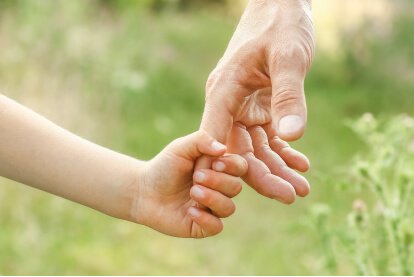What Is Joint Custody and How Does It Affect My Kids?
By Divorce.com staff
Updated Sep 20, 2022
Contents:

You'll make some important decisions when you get a divorce, especially if you have children. Child custody is one of the top reasons divorce proceedings go on longer than most couples would like them to, especially if they don’t get along very well.
When couples can’t see each other, a judge must intervene. They will assess the situation and make a ruling that is in the best interest of the child or children. Read on to learn more about custody arrangements and how they can affect your children’s mental health and overall well-being.

What Is Joint Custody?
Joint custody means parents share parental responsibility and the amount of time they spend with their children, so they must become comfortable with co-parenting. It can be very beneficial to a child to have both parents involved in their life, especially regarding their overall health and well-being. There are two types of joint custody arrangements divorcing parents should know about so they can make a parenting plan and make major decisions together.
Joint Physical Custody
Joint physical custody means both parents can have equal time with their children as a caregiver. Physical custody arrangements spell out where a child lives and the visitation schedule each parent must adhere to. Divorcing parents with this type of custody arrangement cannot attempt to prevent each other from having court-ordered time with the child (ex: keeping the child longer than the agreed-upon time).
If a parent attempts to deny visitation rights at any point, the other parent can file a petition with the court to hold them accountable. It is illegal to deny visitation when there is an active custody order. If you believe your child is in danger in your ex-spouse’s care, you’ll still have to go through the court system to revive their custody.
Joint Legal Custody
Joint legal custody means that both parents are equally involved in decision-making for matters related to their child’s overall well-being. This means things that significantly impact the child’s mental health, physical health, and lifestyle (ex: where the child goes to school). One parent cannot make final determinations on these matters if the other is not in agreement.
Joint Custody: Pros and Cons
As with any situation, there are upsides and downsides to a shared custody arrangement. If you and your ex-spouse are going to share custody, it’s essential to see both sides. Here are some things you’ll need to keep in mind.
Advantages of Joint Custody
- Both parents involved in children’s lives
- Allocation of responsibilities
- Stability for children
Both Parents Involved in Children’s Lives
Divorce can be tough on kids; joint custody can positively impact a child’s mental health. Seeing both parents regularly, especially if they get along well and have practical co-parenting skills, is beneficial to a child’s overall well-being.
Allocation of Responsibilities
Joint custody can also be beneficial to the parents. With sole physical or legal custody, the custodial parent would have to take on all child care and decision-making responsibilities independently. This can be overwhelming for one person, especially if they already have a lot on their plate.
A great thing about joint custody is that parents can divide responsibilities evenly and even help each other out if one of them falls short (ex: they get stuck at work and can’t pick up the child from school). With sole custody, it could be tricky for the custodial parent to find someone to take care of their child at the last minute if an emergency arises.
Stability for Children
With both parents involved in a child’s upbringing, they have a greater sense of stability and predictability. They’ll be able to have both parents attend their sporting events, help them study for the next big test, and consult them both for advice on important matters.
A child can still thrive with a custodial parent, but there are proven mental health benefits to a child having both parents involved in their day-to-day life. Even when parents aren’t living together anymore, their involvement plays a crucial role in their child’s overall well-being.
Drawbacks of Joint Custody
- Scheduling and planning challenges
- Potential conflict
- Kids are constantly moving back and forth.
Scheduling and Planning Challenges
These are some of the most common visitation schedules but not the only options available. You and your ex-spouse can design an arrangement that works best for you and your individual lives.
Standard joint custody schedules:
- Alternating weeks
- 2-2-3
- Every weekend
- Two weeks
- 3-4-4-3
With joint custody, there will inevitably need to be automatic adjustments made to the visitation schedule from time to time. Life happens, and one parent might find that they need to ask the other to keep the child a little longer than initially planned or take them to their soccer game because they’re no longer able to.
Potential Conflict
Co-parenting could be difficult if you and your spouse don’t get along well. Not to mention, making significant decisions with someone can be challenging even if you do get along. With sole physical and legal custody, the custodial parent would not need to consult their ex-spouse before making any final decisions regarding the child’s school location, where they live, and any matters related to their health.
Kids are Constantly Moving Back and Forth
As great as it is for a child to have both parents involved in their life and extracurricular activities, moving back and forth every week (or however the schedule is set up) can be challenging for a child to adjust to. It can also be stressful for the parents if they have busy lives and don’t have much time or energy to coordinate pick-ups and drop-offs regularly.
When Is Joint Custody the Right Option?
Joint custody is best in situations where both parents are on good terms and able to put aside their differences to act in the child's best interest. If this is not the case or not possible, sole physical custody or sole legal custody are other options.
It’s also suitable for cases where naming one parent or the other as the custodial parent wouldn’t be best for the child’s upbringing; like if a parent is so busy, the child would constantly be with a babysitter or nanny while in their care.
How Does Joint Custody Impact Child Support?
While it is unlikely, you could still be obligated to pay child support if you have 50/50 custody. Joint physical and legal custody means that the child lives with both parents part-time and that both parents are involved in the decision-making.
However, it doesn’t mean that one parent couldn’t be entitled to receive child support payments if the judge determines it’s in the child's best interest. If one parent makes significantly more than the other, the judge might order child support to be paid to them, so the child has a similar living experience while staying with the lesser-earning parent.
What if You Disagree With an Arrangement?
If you disagree with the custody arrangement determined by the judge, you can file an appeal. The appeals process varies depending on the laws in your state. If you need legal advice, you can consult a family law attorney on this matter. They can draft an appeal for you.
Please note that not all orders can be appealed ( non-final rulings). Order must be final and complete to be eligible for appeal. This means there are no outstanding court dates. The request should detail what you feel the judge got wrong in their ruling and why their verdict is not in the child's best interest.
Contents:

















